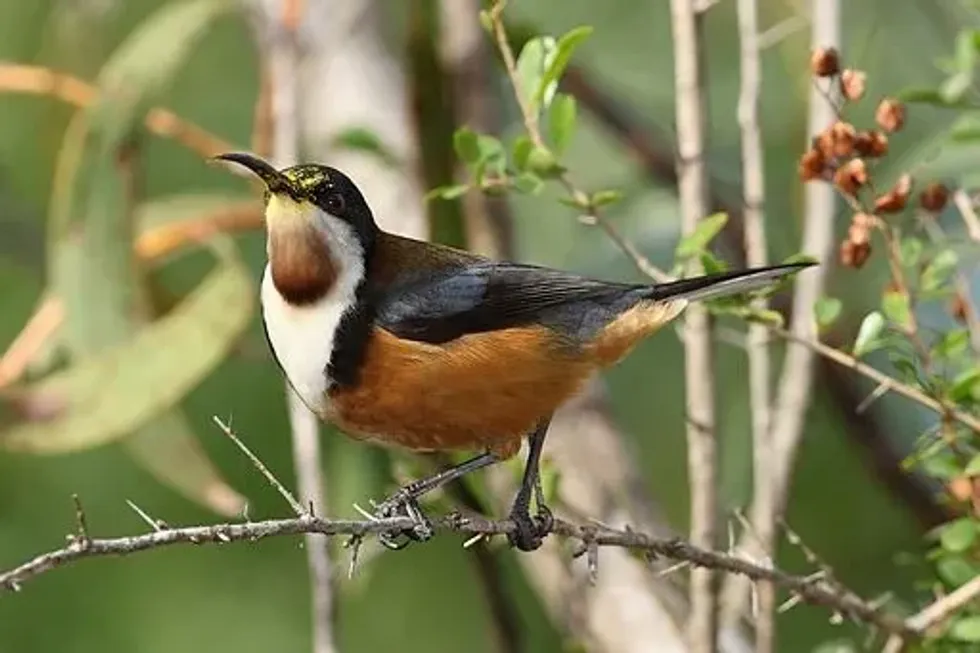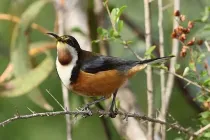Eastern spinebill (Acanthorhynchus tenuirostris) is also called spine-billed honeyeater, awl bird, and cobbler's awl bird. A British ornithologist earlier described the eastern spinebill as Certhia tenuirostris. They are found in areas such as South Australia, Flinders Ranges, Great Dividing Range, Canberra, Sydney, and Melbourne.
These birds have a black head, white throat, and chestnut underparts. The dark tail is tipped laterally with white color.
Climate change has greatly affected their populations. The food habits of his species with long downcurved bills change according to the nectar production. During the low nectar production time, they store more fat and less nectar as compared to the high nectar production time.
Here are some of the most interesting facts about the eastern spinebill (Acanthorhynchus tenuirostris) found in southeastern Australia. Afterwards, do check our other articles on house finch facts and blue jay facts.
Eastern Spinebill Interesting Facts
What type of animal is an eastern spinebill?
Acanthorhynchus tenuirostris (eastern spinebill ) is a bird with a brownish-red nape, gray-brown back and pale cinnamon underparts, dark tail, black head, white throat, thin downcurved black bill, rufous patch in the center of the throat.
What class of animal does an eastern spinebill belong to?
An eastern spinebill belongs to the bird class of Aves with a black, white, and chestnut plumage, red-eye, as well as, a long downcurved bill. Their range falls to the east of the Great Dividing Range.
How many eastern spinebills are there in the world?
The eastern spinebill population has been decreasing over the years. Their exact population size has not been determined by any competent authority as of now in woodland areas, as well as, urban areas of Australia.
Where does an eastern spinebill live?
An eastern spinebill Acanthorhynchus tenuirostris lives in the woods, gardens, and forests in its natural habitat across Australia. Urban populations can be found feeding on the nectar of flowers with the curved bill in Sydney and Melbourne.
What is an eastern spinebill's habitat?
An eastern spinebill habitat consists of forest and woodland areas as well. They are found in low-altitude regions.
These birds build their nests on branches not more than 33 ft (10 m) above the ground. The nests are built by females, but males help to collect ingredients for the nests. They also live in the thick underbrushes of the trees.
This species is sometimes found near human settlements in gardens in urban areas and parks in Melbourne. They live near flowers and gardens to have regular access to nectar from flowers.
Who do eastern spinebills live with?
Eastern spinebills most commonly prefer to live alone. They are sometimes found in small packs with birds of their own species.
How long does an eastern spinebill live?
An eastern spinebill Acanthorhynchus tenuirostris has a very good life expectancy. It can live for more than 13 years.
How do they reproduce?
The breeding season of eastern spinebills is from August to December.These are monogamous birds. The male eastern spinebill approaches females and makes loud mating calls or touches the females' tails with their beaks to get their attention. Once the female agrees both of them take a flight.
The eggs are laid in nests that are built by females on a tree fork in the forest. the clutch size for this bird ranges between one to four eggs.
The average incubation period is 14 days. It takes around 14 days for the fledgling. Females can lay up to five clutches per breeding season.
What is their conservation status?
The conservation status of the eastern spinebill Acanthorhynchus tenuirostris is that of Least Concern. But due to climate change, their populations are getting scattered from their ancestor species.
Eastern Spinebill Fun Facts
What do eastern spinebills look like?
Eastern spinebills are colorful birds. They have a white and chestnut plumage. They have blackhead white throat and chestnut underparts. The dark tail is tipped laterally with white color.
Females of this species have a duller color than the male eastern spinebill. They have cinnamon-brown underparts and gray-brown backs. Their wings are dark gray-brown in color.
They have a chestnut patch on their neck on their gray-brown backs. Females have a gray-black crown. The bills of eastern spinebills are thin downcurved black bills. These birds have red eyes and white outer tail feathers.
How cute are they?
Eastern spinebills are very cute. They are warm-colored colorful birds with white outer tail feathers. Their bills stand out and make them look more attractive.
How do they communicate?
Eastern spinebills have very high-pitched and clear vocals. They use these vocals for communication within their species. They make a chip-chip-chip sound that has a very high note. They can call for long periods of time. Besides that, they use touch and flight for communication.
How big is an eastern spinebill?
The eastern spinebill is a small-sized bird. Its length ranges between 5-6 in (13-16 cm). Eastern spinebills are 1.5 times bigger than a sparrow.
How fast can an eastern spinebill fly?
The speed with which an eastern spinebill can fly is currently unknown. But these are energetic flyers. They move very quickly and swiftly.
How much does an eastern spinebill weigh?
An eastern spinebill is a small-sized bird. Its weight lies in the range of 0.28-0.56 oz (8-16 g).
What are the male and female names of the species?
Males of the eastern spinebill species are called cocks and females of the eastern spinebill species are called hens. Eastern spinebill male and female birds can be seen feeding on nectar from a variety of flowers as well as gum trees in their natural habitat.
What would you call a baby eastern spinebill?
The eastern spinebill baby is called a chick.
What do they eat?
Eastern spinebills are omnivorous birds. They prey on insects. Their herbivorous diet includes nectar from the flowers and gum trees, which is their primary food source.
Are they poisonous?
No, eastern spinebills are not poisonous. Spinebill birds do not have any poison sacks or organs to deposit poison. They are wild birds but not poisonous.
Would they make a good pet?
Eastern spinebills are wild birds. They are not really taken as pets. Though if you want to keep one make sure you can meet their dietary requirements. Spinebill birds feed on nectar from flowers and insects.
Did you know...
A lot of studies or research have been done on this species in the New England National Park in New South Wales.
Males have a gray-black crown that extends in a black line on either side of the breast.
What is the difference between an eastern spinebill and a hummingbird?
Eastern spinebills have a long bill just like the hummingbirds. But the bills of the hummingbirds are straight, while those of eastern spinebills are long downcurved bills. These two species also differ in color from one another. The females of the eastern spinebill species have a gray-black crown.
Do eastern spinebills migrate?
Eastern spinebills do migrate, but they stay in a limited range. They do not travel long distances for migration like other birds. They stay within a fixed region. These birds migrate during the winters.
Here at Kidadl, we have carefully created lots of interesting family-friendly animal facts for everyone to discover! For more relatable content, check out these rufous hummingbird facts and toco toucan facts pages.
You can even occupy yourself at home by coloring in one of our free printable eastern spinebill coloring pages.










